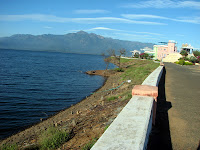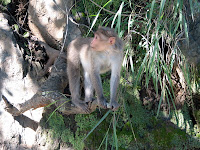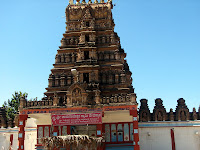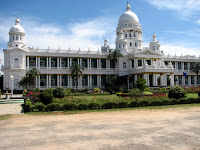 a left Cbt on 24th early morning around 5.30 am. It was Tiruvadarai & full moon day. We could spot the early morning moon setting in glorious golden yellow hues. We travelled through Saravanampatti, Annur & Puliampatti before reaching Sathyamangalam. Here we took a 20 Km detour from the Highway & reached Lower Bhavani Dam & reservoir . The land enroute was rich an
a left Cbt on 24th early morning around 5.30 am. It was Tiruvadarai & full moon day. We could spot the early morning moon setting in glorious golden yellow hues. We travelled through Saravanampatti, Annur & Puliampatti before reaching Sathyamangalam. Here we took a 20 Km detour from the Highway & reached Lower Bhavani Dam & reservoir . The land enroute was rich an d fertile – verdant with banana, sugar cane, paddy. We drove up to the top of the dam to get a magnificent view of the reservoir & the mountain range in the back drop. We used this as a breakfast halt – and gorged ourselves on yummy cheese sandwiches which melted in our mouths !
d fertile – verdant with banana, sugar cane, paddy. We drove up to the top of the dam to get a magnificent view of the reservoir & the mountain range in the back drop. We used this as a breakfast halt – and gorged ourselves on yummy cheese sandwiches which melted in our mouths !Our next destination was the famous town of Bannari – where the legendary Bann
 ari Mariamman temple is located. As the legend goes the idol was discovered by cowherds – one of the cows refused to feed her calf, instead she discharged all her milk on a “puthu” or pit. On digging the villagers found the idol and the goddesses informed them that she had accompanied traders travelling from Mannarkad (in Kerala) providing them divine protection in the forest. She now wished to remain here & wanted the villagers to install her idol and build a temple at the site. The name of the village “Bannari” is derived from “Mannar”-kad. After worshipping there we commenced the steep Dimbam ghat climb – comprising 27 hair pin bends. Ramesh negotiated them with caution but expertly. The scenery at higher altitudes was fascinating & captivating and I could capture some of this on video. This is also the notorious
ari Mariamman temple is located. As the legend goes the idol was discovered by cowherds – one of the cows refused to feed her calf, instead she discharged all her milk on a “puthu” or pit. On digging the villagers found the idol and the goddesses informed them that she had accompanied traders travelling from Mannarkad (in Kerala) providing them divine protection in the forest. She now wished to remain here & wanted the villagers to install her idol and build a temple at the site. The name of the village “Bannari” is derived from “Mannar”-kad. After worshipping there we commenced the steep Dimbam ghat climb – comprising 27 hair pin bends. Ramesh negotiated them with caution but expertly. The scenery at higher altitudes was fascinating & captivating and I could capture some of this on video. This is also the notorious  Sathyamanagalam forest range, home & hiding place of Veerappan the once feared forest brigand, kidnapper & ivory smuggler (Veerappan was shot dead by Tamilnadu Police in 2004). We reached Hasanur the border town between Tamilnadu & Karnataka, and continued on our journey till we reached Chamarajanagar town. Enroute there were more banana, sugarcane plantations. Apart from this we saw plenty of papayas,coconut palms, tamarind, banyan & euc
Sathyamanagalam forest range, home & hiding place of Veerappan the once feared forest brigand, kidnapper & ivory smuggler (Veerappan was shot dead by Tamilnadu Police in 2004). We reached Hasanur the border town between Tamilnadu & Karnataka, and continued on our journey till we reached Chamarajanagar town. Enroute there were more banana, sugarcane plantations. Apart from this we saw plenty of papayas,coconut palms, tamarind, banyan & euc alyptus. Some stretches were lined with silver oak trees & honeysuckle bushes. Chamarajanagar is also a district of Karnataka which shares borders with Erode District of Tamil Nadu and Wayanad District of Kerala. The best temple in this area is the Chamrajeswara complex built by Krishnaraja Wodeyar III. This was built in 1828 in memory of his father - Chamaraja Wodeyar. The sanctum sanctorum has a Shiva Linga which was originally at Sringeri. Transferred to this place it was later named as Chamarajeswara. The goddess is Chamundeswari. The architecture is marvelous & distinct. Special pujas were being offered to the Sahasara Lingam installed there & we received special prasadam of puli hora & sakkara pongal (made from sugar). Shobha also received ‘vettala paku’ from a Kannada family.
alyptus. Some stretches were lined with silver oak trees & honeysuckle bushes. Chamarajanagar is also a district of Karnataka which shares borders with Erode District of Tamil Nadu and Wayanad District of Kerala. The best temple in this area is the Chamrajeswara complex built by Krishnaraja Wodeyar III. This was built in 1828 in memory of his father - Chamaraja Wodeyar. The sanctum sanctorum has a Shiva Linga which was originally at Sringeri. Transferred to this place it was later named as Chamarajeswara. The goddess is Chamundeswari. The architecture is marvelous & distinct. Special pujas were being offered to the Sahasara Lingam installed there & we received special prasadam of puli hora & sakkara pongal (made from sugar). Shobha also received ‘vettala paku’ from a Kannada family.The Chamrajnagar to Nanjangud road was battered & full of potholes and the drive was not so comfortable. We finally reached Nanjangud later than scheduled. This town is known for two things – Hallu Podi (tooth powder) & the Nanjundeswara temple. This day happened to be a special occasion for devotees – being a Monday & that too full moon day. There were huge milling crowds & long queues waiting for the lords Darshan. We purchased special Darsan tickets – but notwithstanding this it took us nearly 2 hours to reach the sanctum of Nanjundeswara (or Srikantesawara). Due to heat and lack of ventilation several ladies & children got d
 ehydrated & swooned. Finally we reached the sanctum. We first worshipped Nanjundeswara & then at Ammanavarugudi or Parvatambal Sannithi and then at Natarajar sannithi. The style of architecture was clearly Dravidian. At the Ambal sannithi we saw the jade lingam donated by Tippu Sultan. As per legend Tippu’s elephant had recovered its eye sight after Tippu prayed to the
ehydrated & swooned. Finally we reached the sanctum. We first worshipped Nanjundeswara & then at Ammanavarugudi or Parvatambal Sannithi and then at Natarajar sannithi. The style of architecture was clearly Dravidian. At the Ambal sannithi we saw the jade lingam donated by Tippu Sultan. As per legend Tippu’s elephant had recovered its eye sight after Tippu prayed to the  deity hence the jade lingam is also known as ‘Hakim’ Nanjundeswara.
deity hence the jade lingam is also known as ‘Hakim’ Nanjundeswara.Nanjundeshwara means the God who drank poison. Hindu mythology quotes an interesting legend in which the Gods and demons churned the ocean in search of the nectar of immortality. During this churning abundant quantity of poison was produced. To prevent the poison from spreading across the universe and destroying it, Shiva came to the rescue and drank the poison. Nanjangud is also known as 'Dakshina Kashi' or Varanasi of the South - the Kapila, Koundinya & Suvarnavathy rivers meet here.
Twice a year worshippers gather for the Chariot Festival locally known as the Dodda
 Jathre and the Chikka Jathre. Idols of Srikanteshwara, Parvathi, Ganapathi, Subramanya and Chandikeshwara are kept in five separate chariots and devotees pull the wooden chariots across the streets of the old town.
Jathre and the Chikka Jathre. Idols of Srikanteshwara, Parvathi, Ganapathi, Subramanya and Chandikeshwara are kept in five separate chariots and devotees pull the wooden chariots across the streets of the old town.As we exited from Ambal sannithi we saw several superb sculptures – Sivam Kalyanam, Dakshinamoorthy, Kalasamharamoorthy, Annapoorni amongst others.
Our final destination and halt for the night was Mysore – at Hotel Ramanasree. We reached around 5.30 pm & checked in to our hotel room . A
 fter a quick wash we left almost immediately to Chamundi Hills for a Darsan of Goddess Chamundeswari. Alas as soon as we reached the shrine @ 6.15 pm, the temple doors closed to reopen again only at 7.45 pm. We did not wait & returned to the Hotel. On our drive down we could sight the full moon in all its glory – a truly elevating experience. Next morning we were up at Chamundi hills once again – this time we had Darsan of Chamundeswari. We bought special Rs.100 darsan tickets and we could directly
fter a quick wash we left almost immediately to Chamundi Hills for a Darsan of Goddess Chamundeswari. Alas as soon as we reached the shrine @ 6.15 pm, the temple doors closed to reopen again only at 7.45 pm. We did not wait & returned to the Hotel. On our drive down we could sight the full moon in all its glory – a truly elevating experience. Next morning we were up at Chamundi hills once again – this time we had Darsan of Chamundeswari. We bought special Rs.100 darsan tickets and we could directly reach the sanctum without having to stand in queue. We also worshipped at the adjacent Mahabaleswara (Siva) temple a small but less celebrated temple. There were no crowds here and we spent a lot of time in meditation & took several photographs of the sculptured
reach the sanctum without having to stand in queue. We also worshipped at the adjacent Mahabaleswara (Siva) temple a small but less celebrated temple. There were no crowds here and we spent a lot of time in meditation & took several photographs of the sculptured  pillars, beautifully carved doorways, the Vimanam, the brass dwaja sthambam etc. This place had a special vibration about it,which has to be actually experienced to be believed. We departed after taking snaps of the Demon Mahisasura battling a huge snake ( the towering statue is installed outside in the bazaar area), we motored down hill again, made a small deviati
pillars, beautifully carved doorways, the Vimanam, the brass dwaja sthambam etc. This place had a special vibration about it,which has to be actually experienced to be believed. We departed after taking snaps of the Demon Mahisasura battling a huge snake ( the towering statue is installed outside in the bazaar area), we motored down hill again, made a small deviati on to reach the cave temple & the huge Nandi installed there. From Chamundi hills we got a panoramic birds eye view of Mysore – the Lalit Mahal Palace, the Race Course, The Lakshmi Vilas Palace, the Lake & other landmarks.
on to reach the cave temple & the huge Nandi installed there. From Chamundi hills we got a panoramic birds eye view of Mysore – the Lalit Mahal Palace, the Race Course, The Lakshmi Vilas Palace, the Lake & other landmarks.Then we returned via Cantonment area - the National Administration Institute, Kanteerava Naras
 imha Raja Sports Institute, Karanji Lake Nature Park & KARP Mounted Police Hqs. The Lakshmi Vilas Palace was located close to our Hotel – it was earlier known as the Amba Vilas Palace. The Lalita Mahal Palace on the foothills of Chamundi (built by Karishna Raja Wodeyar in 1931) is now owned and managed by ITDC operates as a 5 star hotel. Photographs of these magnificent monuments can be seen in the blog.
imha Raja Sports Institute, Karanji Lake Nature Park & KARP Mounted Police Hqs. The Lakshmi Vilas Palace was located close to our Hotel – it was earlier known as the Amba Vilas Palace. The Lalita Mahal Palace on the foothills of Chamundi (built by Karishna Raja Wodeyar in 1931) is now owned and managed by ITDC operates as a 5 star hotel. Photographs of these magnificent monuments can be seen in the blog.


Thanks for your account of these really wonderful places and the photos.
ReplyDelete